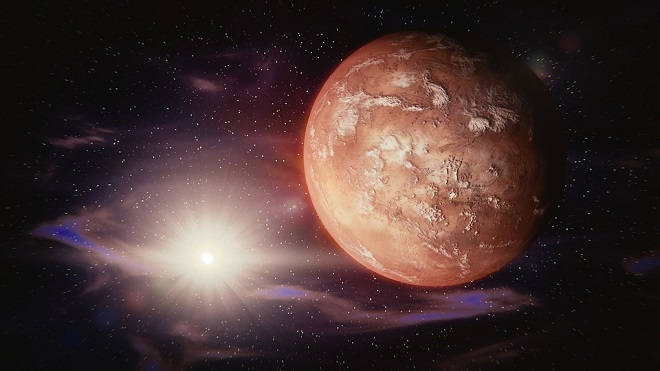The Mars Expedition – Part One
By R.G. Ramsey
eBook Guidance is reader-supported. When you buy through links on our site, we may earn an affiliate commission. As an Amazon Associate, I earn from qualifying purchases. Affiliate Disclosure

Terraforming Mars.
“My name is Richard Andrews, I am one of the founders of Time Escapes Inc.” “We will begin this adventure by launching our main engine spacecraft to Mars with four pods attached to it. One pod will carry the supplies we will need later, and equipment on board to communicate with satellites orbiting above Mars, which will transmit the signal back to Earth.” “The Japanese have also offered their assistance with our endeavor to terraform Mars. After the Fukushima disaster, the Japanese are now experts at removing radiation from the environment, at least in my opinion. I am sure the Japanese could provide substantial evidence to prove my opinion is accurate.” You might also like: Learn about Flash Fiction here...What is Flash Fiction? EBook Guidance is a participant in the Amazon Services LLC Associates Program, an affiliate advertising program designed to provide a means for sites to earn advertising fees by advertising and linking to Amazon.com.
“It pleases us to announce our intention to travel to Mars for the purpose of terraforming Mars.”
“Two of the remaining pods will be for human habitation, in the event we have a manned mission to Mars in the not too distant future. Unlike the tiny accommodations available in the Apollo missions of yesteryear, these pods will be much more spacious for the comfort and sustainability of future space travelers.”
“Unfortunately, these pods are designed for long-term shelter on Mars, and cannot leave the surface of Mars, nor survive re-entry to Earth. What they lack in mobility they make up for in sustainability.”
“They both have their own systems to produce electricity, which are composed of liquid hydrogen and liquid oxygen. The byproduct of using these to create power is water, and breathable oxygen. Being forced to adapt to an environment with an influx of pure water and oxygen to breathe is not a problem for us homo-sapiens.”
“The fourth pod will be a greenhouse to grow food. The Japanese will supply us with a hive of stingless bees to pollinate the crops growing in the greenhouse during our second trip to Mars. Having stingless bees won’t matter much with the people working there dressed in thick spacesuits, impervious to something as insignificant as a bee sting.”
“These stingless bees were kept at the Fukushima nuclear disaster site to pollinate the crops there and are well adapted to working in a high radiation environment.”
“The second trip to Mars will be to plant vegetation on Mars, which will absorb radiation and carbon dioxide, and replace it with oxygen.”
“On the second trip to Mars we will send our primary engine with two space shuttles attached to it. The first space shuttle will be similar to the Challenger and Columbia, which had a limited compartment for the astronauts to live in, and a large cargo hold to transport items into space.”
“The second space shuttle has a much smaller cargo hold, but has a larger area for the astronauts to live in. This space shuttle will also have a much larger fuel tank increasing the range that the shuttle will be able to travel in the event of an emergency.”
“NASA is assisting us in our mission. Their decades of experience and expertise have proved invaluable to the success of our mission. Not wanting to be outdone by a private corporation in such an important task, NASA Is fully on board with us, in our mission to terraform Mars.”
“Botanists from Japan know there are plants, vegetation is probably a better descriptive word that have properties known for absorbing radiation from the area, and releasing oxygen.”
“This vegetation will grow and prosper before developing seedpods to prolong the plant's continued existence. “
“All life-forms want to continue to survive. Animal life, Homo sapiens included, want to breed and continue their bloodline. Viruses want to attach to a host, and replicate themselves before being expelled and moving on to another host. “
“The plethora of flora on earth is no exception. The flora on earth will adapt to its environment, become stronger, and create seedpods that are modified by its parent to be heartier and more resilient to environmental changes. With each generation, the new seed pods become even more adaptable to their environment.”
“The Fukushima disaster happened in 2011.”
“The flora planted in the vicinity of the nuclear disaster back then has now had ten generations of exposure to radiation and hostile environments. They are now the perfect candidates to bury in the ground on Mars in an attempt to terraform Mars.”
“We have also purchased two robots to help maintain the vegetation that will be planted on Mars. These robots do not need food, or oxygen, and will be perfect for working to help terraform Mars. Some suggest however that humans will be needed to safely land the space shuttles on Mars and get things set up.”
“This is only a suggestion at the present moment, but given the fact that NASA has recommended we send both space shuttles to Mars, I believe I can safely assume that they intend to have humans on this mission.”
“We have had discussions about a third and fourth trip to the red planet before it moves further away from Earth, but this has not been definitely decided yet. “
“We will update you later as events unfold.”
Time Travel
Writing Riuals
Previous Story - Joey's New Pet
Next Story - The Canary
Come join us on Facebook Click here...
All links on this site are subject to being sponsored content for which we will receive financial compensation.

